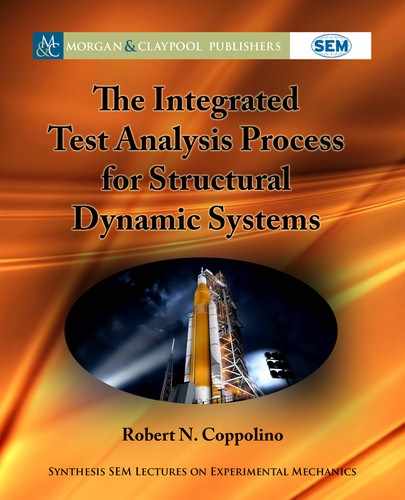130 7. RECONCILIATION OF FINITE ELEMENT MODELS AND MODAL TEST DATA
"
k
O
C
X
i
p
i
k
i
#
Œ
'
a
D
"
m
O
C
X
i
p
i
m
i
#
Œ
'
a
Œ
a
;
Œ
ˆ
D
N
ˆ
OL
Œ
'
: (7.33)
e metric for evaluation of approximate solution convergence is the cross-orthogonality
matrix associated with exact and approximate (RMA) modal sets, specifically,
Œ
COR
ea
D
ˆ
T
e
Œ
M
O
Œ
ˆ
a
: (7.34)
Convergence of the approximate (RMA) modal set is therefore judged on the basis of how
close the (absolute value) cross-orthogonality matrix is to an identity matrix. In addition, the
difference between exact and approximate corresponding modal frequencies is also employed as
part of convergence evaluation.
Before engaging in the actual RMA convergence study, a preliminary evaluation of modal
sensitivities for each of the 28 parametric variations (parameter change set to a value of p
i
D 1)
was conducted, wherein the cross-orthogonality between the baseline modes and exact perturbed
modes,
Œ
COR
eO
D
ˆ
T
e
Œ
M
O
Œ
ˆ
O
; (7.35)
and corresponding modal frequencies were evaluated. Results of that exercise, summarized in
Table 7.1 (note DF represents modal frequency change), indicate that 13 of the total of 28
parametric variations were insignificant.
It should be noted that the numerical values provided in the above table are the peak
frequency and cross-orthogonality alterations associated with the lowest 60 normal modes of
each “unit” parametric variation. As a result of this finding, only the “sensitive” 16 parameters
were evaluated in the RMA convergence study.
Results associated with the RMA convergence study, which used “unit” parametric vari-
ations and values of tolerance .tol/ set to 1e-4, 1e-5, and 1e-6, respectively, are summarized in
Table 7.2.
It is clear from the above results that tol D 1e-6 produces highly converged RMA modes
for the ISPE.
7.1.7 CLOSURE
Alteration of a structural dynamic model for the purpose of reconciliation with respect to mea-
sured data typically requires moderate to large variation in (stiffness and/or mass) parameters.
Moreover, even when small parametric variations of parameters are required, close spacing of
system modes produces large variations in modal vectors. erefore, modal derivatives are not
well suited for tracking of parametric sensitivities of structural dynamic modes. A more robust
strategy for approximate modal sensitivity analysis employs the Ritz method. Specifically, SDM

7.1. PART 1: FINITE ELEMENT MODEL MODAL SENSITIVITY 131
Table 7.1: Evaluation of the significance of ISPE model parametric variations
Case
1.2c.mat
1.3c.mat
1.4c.mat
1.5c.mat
1.6c.mat
1.7c.mat
1.8c.mat
1.9c.mat
1.10c.mat
1.11c.mat
1.12c.mat
1.13c.mat
1.14c.mat
1.15c.mat
1.16c.mat
1.17c.mat
1.18c.mat
1.19c.mat
1.20c.mat
1.21c.mat
1.22c.mat
1.23c.mat
1.24c.mat
1.25c.mat
1.26c.mat
1.27c.mat
1.28c.mat
1.29c.mat
1.30c.mat
DF (%)
4
5
9
13
13
2
1
1
0
1
1
2
4
0
0
2
23
1
6
3
2
23
16
8
28
0
0
0
0
100-Cor (%)
31
30
17
97
90
35
3
7
0
7
10
81
22
0
1
8
95
6
93
89
15
100
100
2
100
0
0
0
0
Class
Sensitive
Insensitive
Insensitive
Sensitive
Insensitive
Sensitive
Typical Sensitive Case
Baseline File: 1.1c.mat, Off-Nominal File: 1.2c.mat
Typical Insensitive Case
Baseline File: 1.1c.mat, Off-Nominal File: 1.8c.mat
5
4
3
2
1
0
-1
100
80
60
40
20
0
10 20 30 40 50 60
10 20 30
Mode
40 50 60
5
4
3
2
1
0
-1
100
80
60
40
20
0
10 20 30 40 50 60
10 20 30
Mode
40 50 60
DF (%)DF (%)100-Cor (%) 100-Cor (%)
Sensitive
Insensitive

132 7. RECONCILIATION OF FINITE ELEMENT MODELS AND MODAL TEST DATA
Table 7.2: Summary of RMA convergence study results
Tolerance 1.00E-04 1.00E-05 1.00E-06
Residuals 65 160 291
Case
|∆f| (%) |∆C| (%) |∆f| (%) |∆C| (%) |∆f| (%) |∆C| (%)
1.2c.mat 1.5 11 1.2 10 0.1 3
1.3c.mat 2.3 16 1.9 16 0.0 1
1.4c.mat 3.2 33 1.6 29 0.1 1
1.5c.mat 1.0 16 0.5 1 0.2 0
1.6c.mat 1.3 1 1.0 3 0.1 0
1.7c.mat 0.4 8 0.4 4 0.1 0
1.13c.mat 0.3 12 0.1 2 0.0 0
1.14c.mat 2.5 16 0.6 5 0.0 0
1.18c.mat 0.7 19 0.1 0 0.0 0
1.20c.mat 3.0 20 1.4 7 0.1 2
1.21c.mat 0.7 15 0.3 1 0.0 1
1.22c.mat 0.4 7 0.2 1 0.1 1
1.23c.mat 1.0 4 0.5 3 0.1 0
1.24c.mat 0.1 0 0.1 0 0.0 0
1.25c.mat 1.7 99 0.6 6 0.1 1
1.26c.mat 0.9 5 0.2 2 0.0 0
Notes:
1. |∆f| (%) = [approximate−exact frequency]/[exact frequency] (%)
2. |∆C| (%) = 100% - [Cross-Othogonality] (%)
3. |∆f| and |∆C| are the envelopes associated with the lowest 60 system modes
employs a truncated set of baseline system modes as trial vectors to define reduced order mass
and stiffness matrices. SDM is a mathematically stable method for approximate parametric sen-
sitivity analysis; however, the baseline system modes are often not adequate for accurate tracking
of sensitivities.
RMA is a methodology that defines trial vectors that augment baseline structure modes,
resulting in substantially improved the ability of SDM to efficiently track parametric sensitivities
of structural modes. RMA employs (a) system modes associated with large reference parametric
alterations and (b) SVD to define a reduced set of residual vectors that are rich in dominant
geometric changes experienced by the subject structural system. Since its introduction in 2001,
RMA has been successfully employed during several modal tests and a variety of mathematical
..................Content has been hidden....................
You can't read the all page of ebook, please click here login for view all page.
